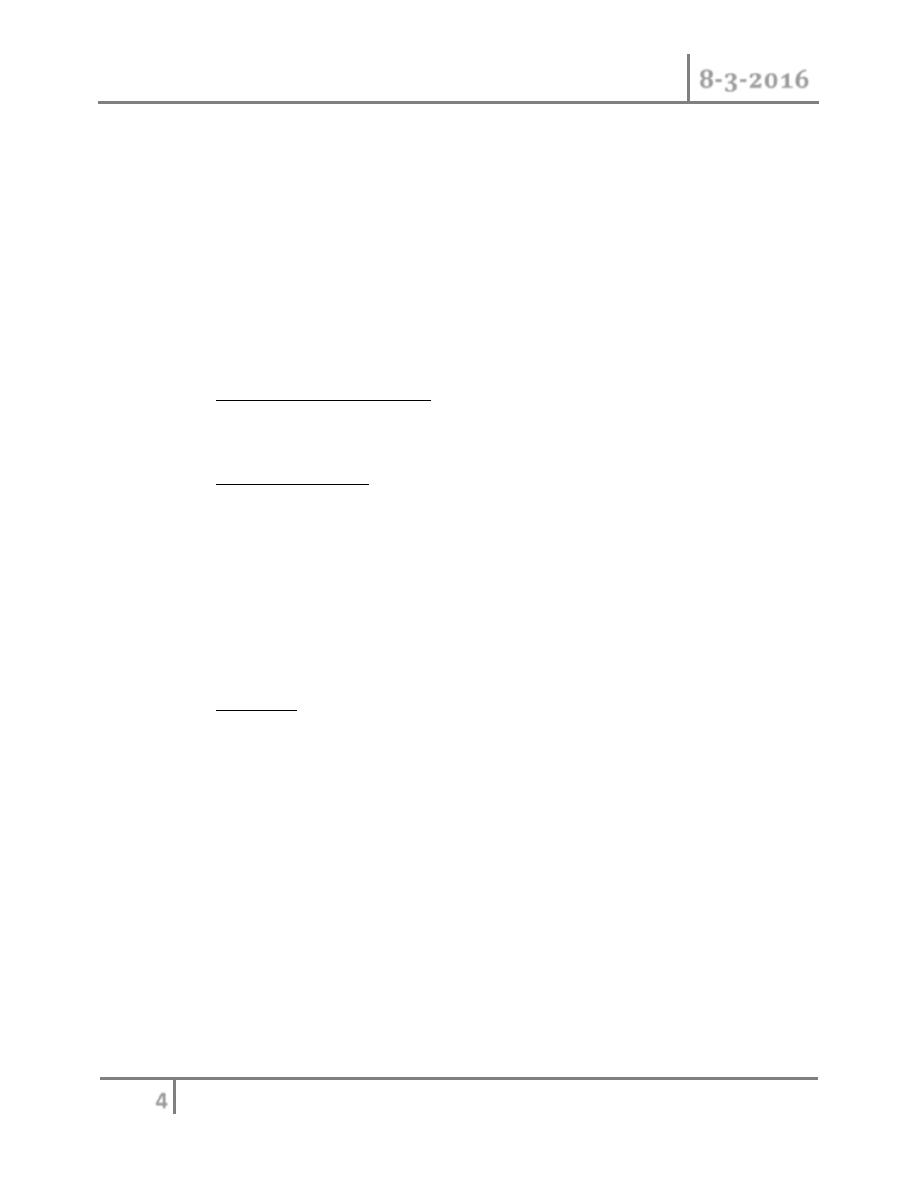
Baghdad College of Medicine / 4
th
grade
Student’s Name :
Dr. Tharwat Edrees
Lec. 4
HERNIA
Tues. 8 / 3 / 2016
DONE BY : Ali Kareem
مكتب اشور لالستنساخ
2015 – 2016

Hernia Dr. Tharwat Edrees
8-3-2016
2
©Ali Kareem 2015-2016
Hernia
UMBILICAL HERNIA
o This is a hernia through a weak umbilicus.
o The hernia is often symptomless but increase in size on crying. Usually in
children or infants.
o Obstruction or strangulation below the age of 3 years is extremely
uncommon.
Treatment
o Conservative treatment is indicated under the age of 2 years when the
hernia is symptomless, reassurance of parents is all that is necessary, as
95% of hernias will disappear spontaneously.
o If the hernia persist at 2 years of age or older it is unlikely to resolve and
herniotomy and herniorrhaphy is indicated.
PARAUMBILICAL HERNIA (Supraumbilical hernia, or infraumbilical hernia)
o In adults the hernia does not occur through the umbilical scar but is a
protrusion through the linea alba, just above or sometimes below the
umbilicus.
o The neck of the sac is often remarkably narrow compared with the size of the
sac and the volume of its contents, which usually consist of greater omentum
often accompanied by small intestine and sometimes even transverse colon.
o In longstanding cases the sac sometimes becomes loculated because of
adherence of omentum to its fundus.
o Women are affected five times more frequently than men. The patient is
usually overweight and between the ages of 35 and 50.
o Increasing obesity, with flabbiness of the abdominal muscles, and repeated
pregnancies are important etiological factors.

Hernia Dr. Tharwat Edrees
8-3-2016
3
©Ali Kareem 2015-2016
o Strangulation is a frequent complication of a large paraumbilical hernia in
adults.
Treatment
If the hernia is untreated it increases in size and its contents become irreducible.
Eventually, strangulation may occur. Thus, operation should be advised in nearly
all cases.
Paraumbilical hernioplasty
In the case of very large primary paraumbilical hernias (fascial defects > 4 cm) or
for recurrent paraumbiical hernias, the use of prosthetic material (Polypropylene
mesh) is recommended.
EPIGASTRIC HERNIA
o An epigastric hernia occurs through the linea alba anywhere between the
xiphoid process and the umbilicus, usually midway between these structures.
o A swelling the size of pea consists of protrusion of extraperitoneal fat only
usually symptomless bur sometimes painful.
o If it is painful or large, treatment by surgery.
THE ABDOMINAL WALL
Burst abdomen
Abdominal wound bursts open and viscera are extruded. Occurs in 1-2 % of cases,
mostly between the sixth and eighth day after operation. The disruption of the
wound tends to occur a few days beforehand when the sutures apposing the deep
layers (peritoneum, posterior rectus sheath) tear through.

Hernia Dr. Tharwat Edrees
8-3-2016
4
©Ali Kareem 2015-2016
Incisional hernia
Usually starts as a symptomless partial disruption of the deeper layers during the
immediate or early postoperative period, the event passing unnoticed if the skin
wound remains intact after the skin sutures have been removed.
Factors predisposing to the incidence of burst abdomen and incisional hernia
1. Technique of wound closure
o Choice of suture material : Catgut leads to a higher incidence of
“bursts” than the use of non-absorbable monofilament polypropylene,
polyamide or wire
o Method of closure :
Interrupted suturing has a low incidence of bursts
Interrupted „far and near‟ sutures are a recommended
technique for single layer mass closures.
When continuous suturing of layers (one or two) is used the
golden is to insert a length of suture that is a least four times
but less than five times the length of the incision. This ensures
that the layers are gently apposed.
o Drainage : directly through a wound leads to a higher incidence of
bursts than employing drainage through a separate (stab) incision.
2. Type of incision
Midline and vertical incisions have a greater tendency to burst than those
that are transverse .
3. Reasons for initial operation
Operations on the pancreas, with leakage of enzymes, and on obstructed
cases are other reasons for disruption. Trauma cases are more prone to
infection and wound dehiscence.
4. Deep wound infection
Is notorious for causing burst abdomen and/or late incisional hernia.
5. Coughing, vomiting and distension
6. General condition of the patient

Hernia Dr. Tharwat Edrees
8-3-2016
5
©Ali Kareem 2015-2016
Obesity, jaundice, malignant disease, hypoproteinaemia and anaemia are all
factors conducive to disruption of a laparotomy wound.
Burst abdomen (abdominal dehiscence)
Clinical Features
A serosanguinous (pink) discharge from the wound is a forerunner of disruption in
50 % of cases if skin sutures have been removed, omentum or coils of intestine may
be forced through the wound and will be found lying on the skin.
Treatment
An emergency operation is required to replace the bowel, relieve any obstruction
and re-suture the wound.
Incisional hernia (Postoperative hernia)
Etiology
o Incisional hernia occurs most often in obese individuals, and a
persistence postoperative cough and postoperative abdominal
distension are its precursors.
Clinical Features
o There are great variations in the degree of herniation. The hernia may
occur through a small portion of the scar, often the lower end.
o More frequently there is a diffuse bulging of the whole length of the
incision.
o It usually increases steadily in size and becomes irreducible.

Hernia Dr. Tharwat Edrees
8-3-2016
6
©Ali Kareem 2015-2016
o Attacks of partial intestinal obstruction are common and
strangulation is liable to occur at the neck of small sac or in a loculus
of a large one.
o Nevertheless, most cases of incisional hernia are asymptomatic and
broad-necked and do not need treatment.
Treatment
o Palliative
An abdominal belt is sometimes satisfactory, especially in cases of a hernia
through an upper abdominal incision.
o Operation
Direct apposition by prolene in small defects
Mesh repair preperitoneal (inlay) or onlay mesh laparoscopic repair
END OF THIS LECTURE…
